Measurement of Building Carbon Emissions and Its Decoupling Relationship with the Construction Land Area in China from 2010 to 2020
Abstract
1. Introduction
2. Data Sources and Methods
2.1. Data Sources
2.2. Calculation of BCE
2.3. Decoupling Model
3. Results
3.1. The Spatiotemporal Pattern of BCE
3.1.1. The Spatial Cluster Pattern of BCE During 2010–2020
3.1.2. The Changes in BCE
3.2. The Spatiotemporal Pattern of CLA
3.3. Decoupling Relationship Between BCE and CLA
4. Discussion
4.1. Improvements of the Measurement of BCE
4.2. Region-Specific Policy Implementation
4.3. Limitations and Future Research
5. Conclusions
- (1)
- BCE in the provinces studied exhibited an overall increase from 2010 to 2020; however, the growth rate decelerated. Specifically, the growth rate decreased from 18.76 million tons during the period of 2010–2015 to 15.77 million tons from 2015 to 2020. DBCE accounted for over 90% of total emissions, while IBCE experienced the slowest growth rate and even a decline in several provinces. The emission reduction efforts within the building materials production industry have proven effective, and minimizing the use of fossil fuels will be the most critical strategy for future emission reductions.
- (2)
- The evolution of BCE demonstrates spatial heterogeneity. BCE and DBCE were higher in the northern provinces but lower in the southern ones. Conversely, provinces with elevated IBCE were primarily concentrated along the eastern coast. Regions experiencing significant increases in BCE and DBCE included Inner Mongolia, Shandong, and Shanxi in northern China. In contrast, provinces in northern China exhibited either a decrease or a slower growth rate in IBCE.
- (3)
- CLA was larger in the northern regions but smaller in the southern regions; however, its growth rate in the North has been lower than that in the South in recent years. The provinces with the largest CLA primarily extend from North China to Northeast China. Notably, the trend in CLA shifted from a consistent increase between 2010 and 2015 to a decline in several provinces in North China and Northeast China between 2015 and 2020.
- (4)
- The decoupling relationship between BCE and CLA was characterized by expansive negative decoupling or strong negative decoupling, particularly evident in the later stages of the study. This indicates that BCEs were increasing at a faster rate than the expansion of CLA. Notably, provinces exhibiting strong decoupling, such as Inner Mongolia, Shanxi, and Heilongjiang in northern China, will be critical areas for future emission reduction efforts.
Author Contributions
Funding
Data Availability Statement
Conflicts of Interest
References
- Withey, P.; Johnston, C.; Guo, J. Quantifying the global warming potential of carbon dioxide emissions from bioenergy with carbon capture and storage. Renew. Sustain. Energy Rev. 2019, 115, 109408. [Google Scholar] [CrossRef]
- Ohene, E.; Chan, A.P.C.; Darko, A. Review of global research advances towards net-zero emissions buildings. Energy Build. 2022, 266, 112142. [Google Scholar] [CrossRef]
- Cai, W. Analyzing Impact Factors of Building Energy Consumption: Modeling and Empirical Study. Ph.D. Thesis, Chongqing University, Chongqing, China, 2011. [Google Scholar]
- Intergovernmental Panel on Climate Change. Climate Change 2007: Synthesis Report. Contribution of Working Groups i. II and III to the Fourth Assessment Report of the Intergovernmental Panel on Climate Change; Intergovernmental Panel on Climate Change: Geneva, Switzerland, 2007. [Google Scholar]
- Guan, D.; Meng, J.; Reiner, D.M.; Zhang, N.; Shan, Y.; Mi, Z.; Shao, S.; Liu, Z.; Zhang, Q.; Davis, S.J. Structural decline in China’s CO2 emissions through transitions in industry and energy systems. Nat. Geosci. 2018, 11, 551–555. [Google Scholar] [CrossRef]
- Chang, K.; Wang, S. Impact of dual-carbon attention competition from local government on regional carbon emissions in China. J. Environ. Manag. 2025, 374, 124064. [Google Scholar] [CrossRef] [PubMed]
- Xiong, X.; Li, X.; Chen, S.; Chen, D.; Lin, J. Review and prediction: Carbon emissions from the materialization of residential buildings in China. Sustain. Cities Soc. 2025, 121, 106211. [Google Scholar] [CrossRef]
- Zhou, N.; Khanna, N.; Feng, W.; Ke, J.; Levine, M. Scenarios of energy efficiency and CO2 emissions reduction potential in the buildings sector in China to year 2050. Nat. Energy 2018, 3, 978–984. [Google Scholar] [CrossRef]
- Building Energy Conservation Research Center, Tsinghua University. Annual Development Report of Building Energy Conservation in China; China Environmental Science Press: Beijing, China, 2018. [Google Scholar]
- Holtz-Eakin, D.; Selden, T.M. Stoking the fires? CO2 emissions and economic growth. J. Public Econ. 1995, 57, 85–101. [Google Scholar] [CrossRef]
- Otim, J.; Mutumba, G.S. Carbon emissions, economic governance and economic growth. Next Res. 2025, 2, 100200. [Google Scholar] [CrossRef]
- Amin, N.; Sharif, A.; Shabbir, M.S.; Pan, Y. Evaluating the impact of natural resource rents, r&d expenditures, green finance and energy efficiency on carbon emissions in BRICS economies: Greening the path to carbon neutrality in the post-COP 27 era. Technol. Soc. 2025, 81, 102826. [Google Scholar]
- Pickson, R.B.; Gui, P.; Jian, L.; Boateng, E. Do population-related factors matter for carbon emissions? Lessons from different income groups of countries. Urban Clim. 2024, 55, 101934. [Google Scholar] [CrossRef]
- Siegl, S.; Hagenbucher, S.; Niggli, U.; Riedel, J. Addressing dairy industry’s scope 3 greenhouse gas emissions by efficiently managing farm carbon footprints. Environ. Chall. 2023, 11, 100719. [Google Scholar] [CrossRef]
- Wei, Q.; Xue, L.; Zhang, H.; Chen, P.; Yang, J.; Niu, B. Spatiotemporal analysis of carbon emission efficiency across economic development stages and synergistic emission reduction in the Beijing-Tianjin-Hebei region. J. Environ. Manag. 2025, 377, 124609. [Google Scholar] [CrossRef] [PubMed]
- Zhu, B.; Zhang, Y.; Zhang, M.; He, K.; Wang, P. Exploring the driving forces and scenario analysis for China’s provincial peaks of CO2 emissions. J. Clean. Prod. 2022, 378, 134464. [Google Scholar] [CrossRef]
- Shi, K.; Liu, G.; Cui, Y.; Wu, Y. What urban spatial structure is more conducive to reducing carbon emissions? A conditional effect of population size. Appl. Geogr. 2023, 151, 102855. [Google Scholar] [CrossRef]
- Zhang, J.; Jiang, H.; Liu, G.; Zeng, W. A study on the contribution of industrial restructuring to reduction of carbon emissions in china during the five five-year plan periods. J. Clean. Prod. 2018, 176, 629–635. [Google Scholar] [CrossRef]
- Hussain, A.; Huseynova, A.; Hakimova, Y.; Nassani, A.A.; Bo, B. Energy efficiency and emission flexibility: Management and economic insights for renewable energy integration. Energy Strateg. Rev. 2025, 57, 101631. [Google Scholar] [CrossRef]
- Du, J.; Thill, J.; Peiser, R.B.; Feng, C. Urban land market and land-use changes in post-reform China: A case study of Beijing. Landsc. Urban Plan. 2014, 124, 118–128. [Google Scholar] [CrossRef]
- Liang, L.; Chen, M.; Luo, X.; Xian, Y. Changes pattern in the population and economic gravity centers since the reform and opening up in China: The widening gaps between the south and north. J. Clean. Prod. 2021, 310, 127379. [Google Scholar] [CrossRef]
- Rahman, M.N.; Akter, K.S.; Faridatul, M.I. Assessing the impact of urban expansion on carbon emission. Environ. Sustain. Indic. 2024, 23, 100416. [Google Scholar] [CrossRef]
- Yang, Y.; Yang, M.; Zhao, B.; Lu, Z.; Sun, X.; Zhang, Z. Spatially explicit carbon emissions from land use change: Dynamics and scenario simulation in the beijing-tianjin-hebei urban agglomeration. Land Use Policy 2025, 150, 107473. [Google Scholar] [CrossRef]
- Li, J.; Huang, X.; Kwan, M.; Yang, H.; Chuai, X. The effect of urbanization on carbon dioxide emissions efficiency in the yangtze river delta, China. J. Clean. Prod. 2018, 188, 38–48. [Google Scholar] [CrossRef] [PubMed]
- Cheng, Y.; Wang, Z.; Ye, X.; Wei, Y.D. Spatiotemporal dynamics of carbon intensity from energy consumption in China. J. Geogr. Sci. 2014, 24, 631–650. [Google Scholar] [CrossRef]
- Li, N.; Qi, L.; Jiang, S. The interactive relationship among construction land expansion, carbon emission, water resource and energy consumption in the suburb of Chongqing over the past 26 years. Desalin. Water Treat. 2018, 125, 148–155. [Google Scholar] [CrossRef]
- Houghton, R.A.; House, J.I.; Pongratz, J.; Van, D.W.G.R.; Defries, R.S.; Hansen, M.C.; Le Quéré, C.; Ramankutty, N. Carbon emissions from land use and land-cover change. Biogeosciences 2012, 9, 5125–5142. [Google Scholar] [CrossRef]
- Li, Y.; Cai, M.; Wu, K.; Wei, J. Decoupling analysis of carbon emission from construction land in shanghai. J. Clean. Prod. 2019, 210, 25–34. [Google Scholar] [CrossRef]
- Wang, M.; Wang, Y.; Wu, Y.; Yue, X.; Wang, M.; Hu, P. Identifying the spatial heterogeneity in the effects of the construction land scale on carbon emissions: Case study of the Yangtze river economic belt, China. Environ. Res. 2022, 212, 113397. [Google Scholar] [CrossRef]
- Cesar De Oliveira, S.E.M.; Visentin, J.C.; Pavani, B.F.; Branco, P.D.; de Maria, M.; Loyola, R. The european union-mercosur free trade agreement as a tool for environmentally sustainable land use governance. Environ. Sci. Policy 2024, 161, 103875. [Google Scholar] [CrossRef]
- Asamoah, P.S.; Takyi, S.A.; Liwur, S.B.; Amponsah, O.; Duamor, S.N. Situating the compliance with land use regulations within the context of sustainable city development: Lessons from ho municipality of Ghana. Urban Gov. 2025, 5, 79–93. [Google Scholar] [CrossRef]
- Liu, J.; Liu, M.; Zhuang, D.; Zhang, Z.; Deng, X. Study on spatial pattern of land-use change in China during 1995–2000. Sci. China 2003, 46, 374–384. [Google Scholar] [CrossRef]
- National Geomatics Center of China Standard Map Service. Available online: http://bzdt.ch.mnr.gov.cn/download.html?superclassName=%25E5%25AE%25A1%25E5%259B%25BE%25E5%258F%25B7 (accessed on 5 March 2025).
- Azari, R.; Abbasabadi, N. Embodied energy of buildings: A review of data, methods, challenges, and research trends. Energy Build. 2018, 168, 225–235. [Google Scholar] [CrossRef]
- Huo, T.; Ren, H.; Zhang, X.; Cai, W.; Feng, W.; Zhou, N.; Wang, X. China’s energy consumption in the building sector: A statistical yearbook-energy balance sheet based splitting method. J. Clean. Prod. 2018, 185, 665–679. [Google Scholar] [CrossRef]
- Yang, X. Research on Building Energy Conservation in China Based on Energy Consumption Data. Ph.D. Thesis, Tsinghua University, Beijing, China, 2009. [Google Scholar]
- Cang, Y.; Yang, L.; Luo, Z.; Zhang, N. Prediction of embodied carbon emissions from residential buildings with different structural forms. Sustain. Cities Soc. 2020, 54, 101946. [Google Scholar] [CrossRef]
- Pan, W.; Li, K.; Teng, Y. Rethinking system boundaries of the life cycle carbon emissions of buildings. Renew. Sustain. Enery Rev. 2018, 90, 379–390. [Google Scholar] [CrossRef]
- Feng, B.; Wang, X. Research on carbon decoupling effect and influence factors of provincial construction industry in China. China Popul. Resour. Environ. 2015, 25, 28–34. [Google Scholar]
- Intergovernmental Panel on Climate Change. Revised 1996 IPCC Guidelines for National Greenhouse Gas Inventories; Intergovernmental Panel on Climate Change: Paris, France, 1997. [Google Scholar]
- Li, Z. Study on the Life Cycle Consumption of Energy and Resource of Air Conditioning in Urban Residential Building in China. Ph.D. Thesis, Tsinghua University, Beijing, China, 2008. [Google Scholar]
- Carter, A.P. The economic of technological change. Sci. Am. 1996, 214, 25–31. [Google Scholar] [CrossRef]
- OECD. Decoupling: A Conceptual Overview; OECD: Paris, France, 2001. [Google Scholar]
- Tapio, P. Towards a theory of decoupling: Degrees of decoupling in the EU and the case of road traffic in finland between 1970 and 2001. Transp. Policy 2005, 12, 137–151. [Google Scholar] [CrossRef]
- Chen, C.; Zhang, L.; Zhou, C.; Luo, Y. Physics-informed explainable encoder-decoder deep learning for predictive estimation of building carbon emissions. Renew. Sustain. Energ. Rev. 2025, 213, 115478. [Google Scholar] [CrossRef]
- Li, X.; Zhu, C. Summary of research on account of carbon emission in building industry and analysis of its influential factors. J. Saf. Environ. 2020, 20, 317–327. [Google Scholar]
- Liu, M.; Meng, J.; Liu, B. Progress in the studies of carbon emission estimation. Trop. Geogr. 2014, 34, 248–258. [Google Scholar]
- Cai, Y.; Su, S.; Zhang, P.; Chen, M.; Wang, Y.; Xie, Y.; Tan, Q. Quantifying high-resolution carbon emissions driven by land use change in the Guangdong-Hong Kong-Macao greater bay area. Urban Clim. 2024, 55, 101943. [Google Scholar] [CrossRef]
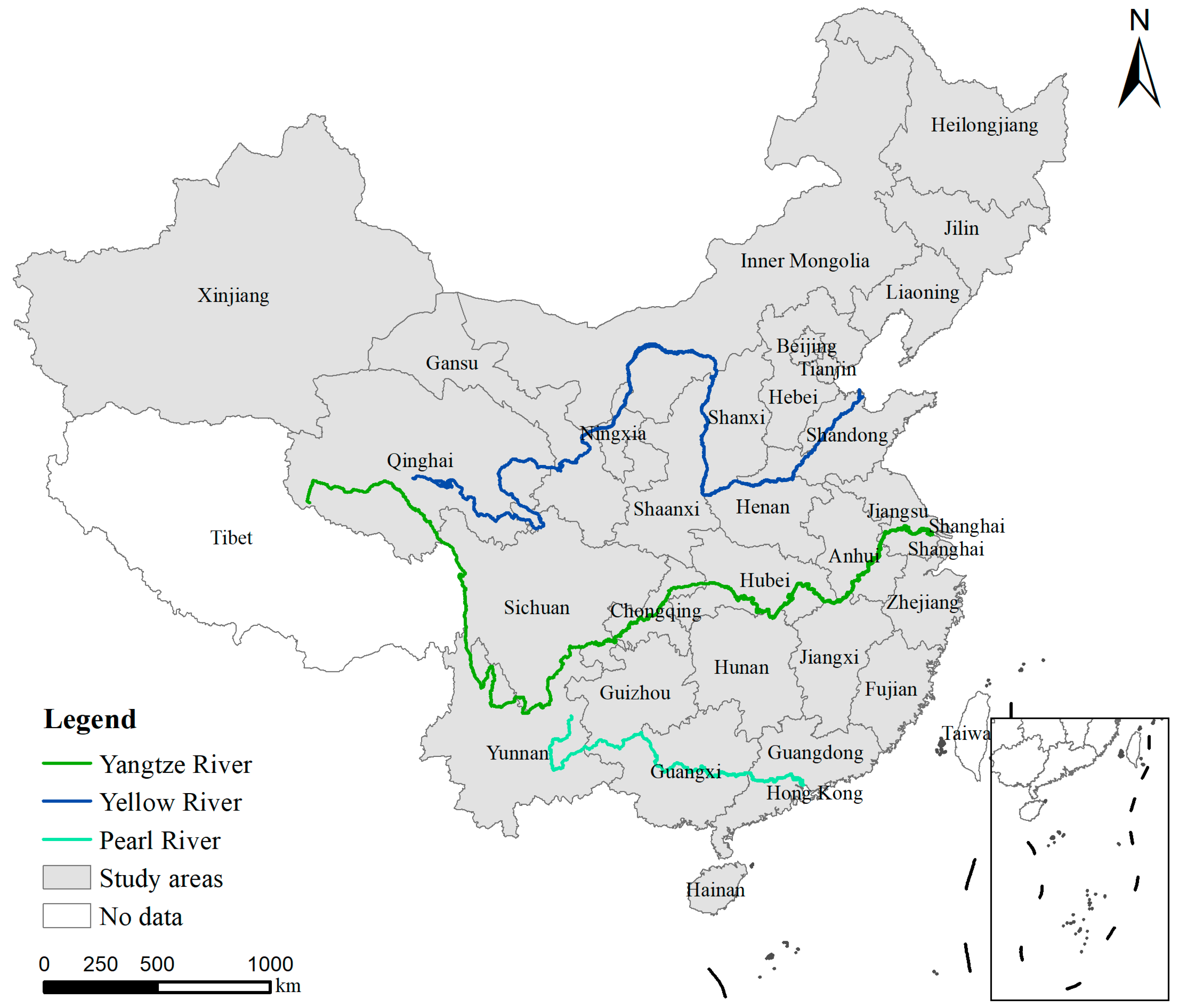
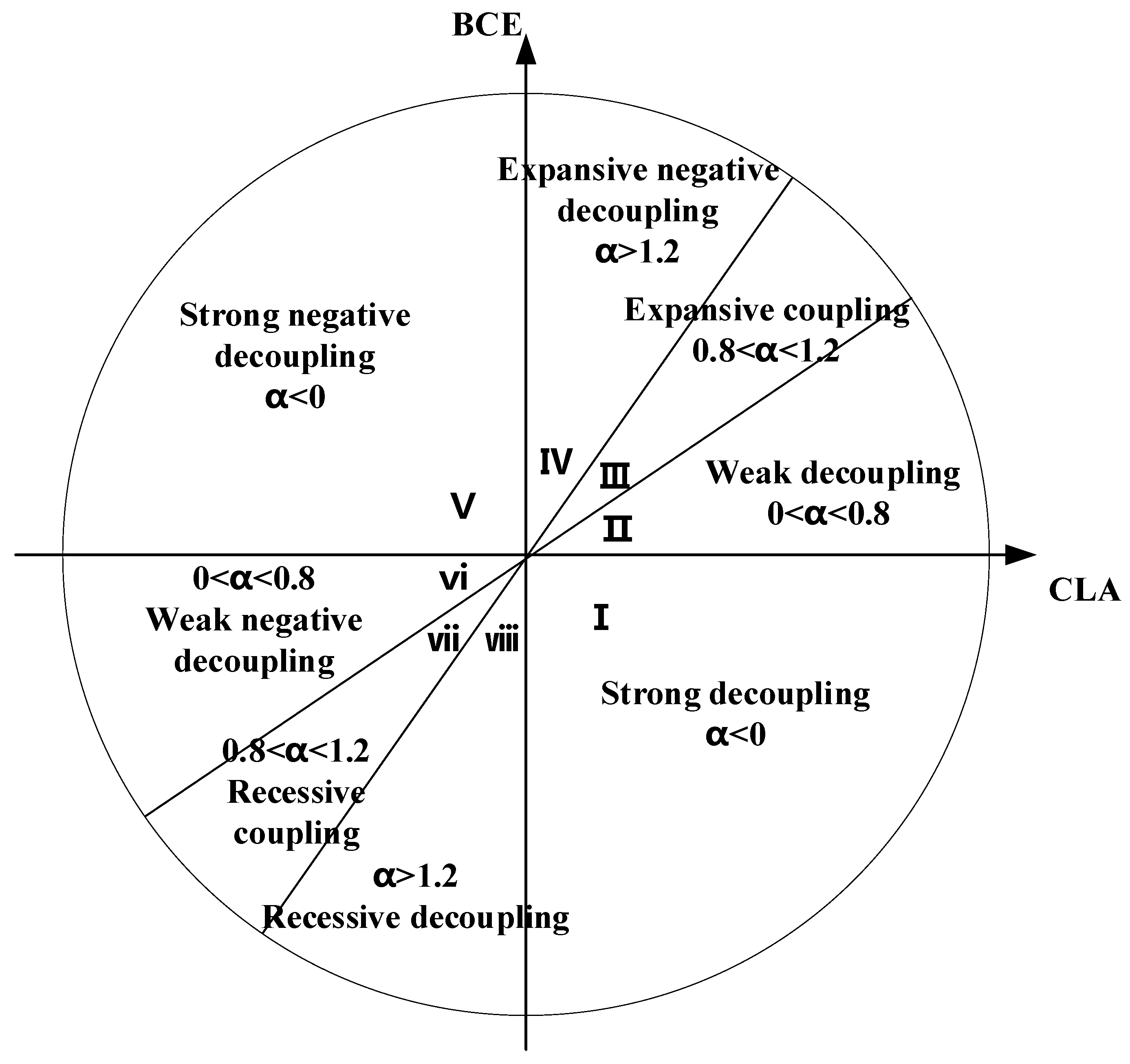
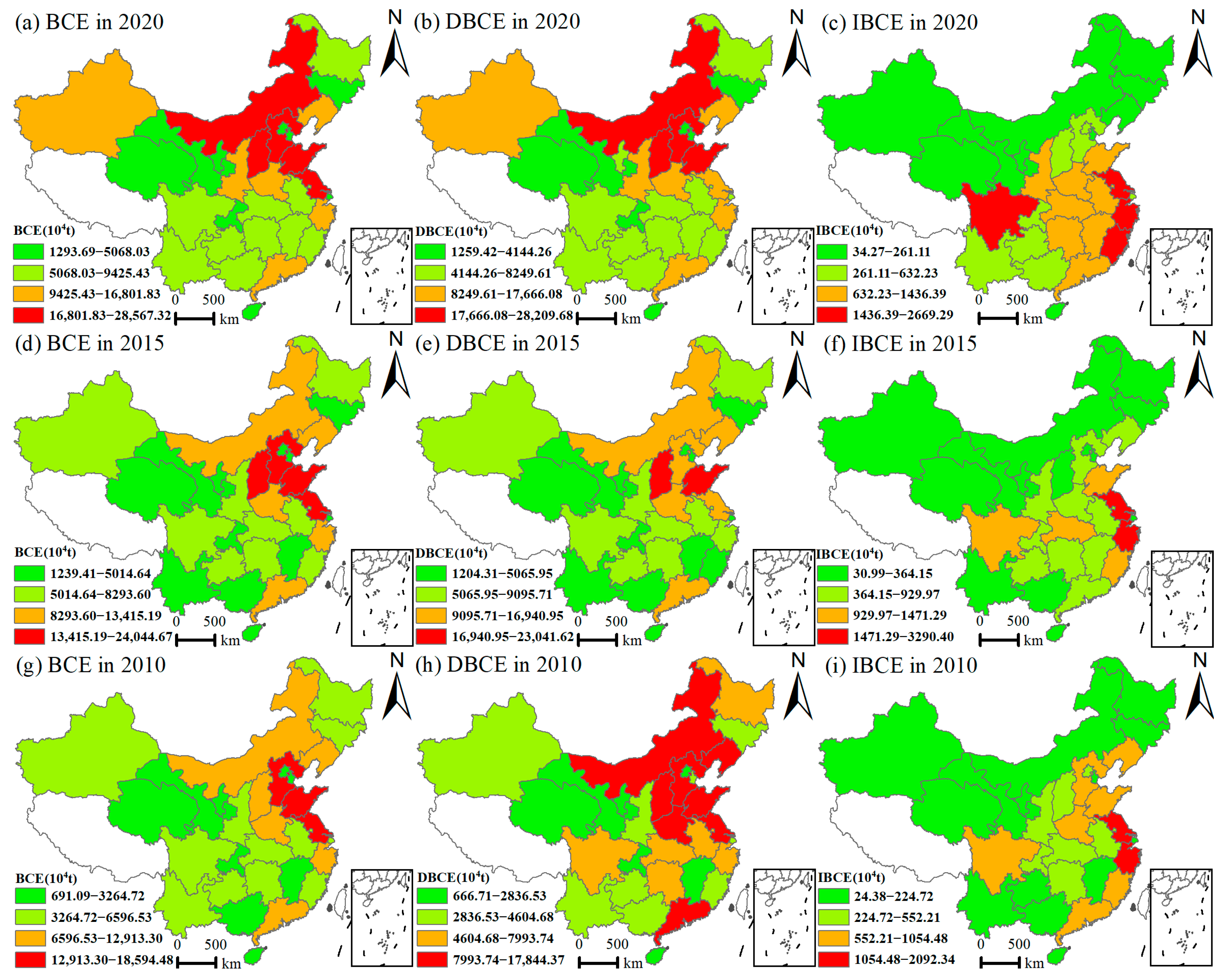

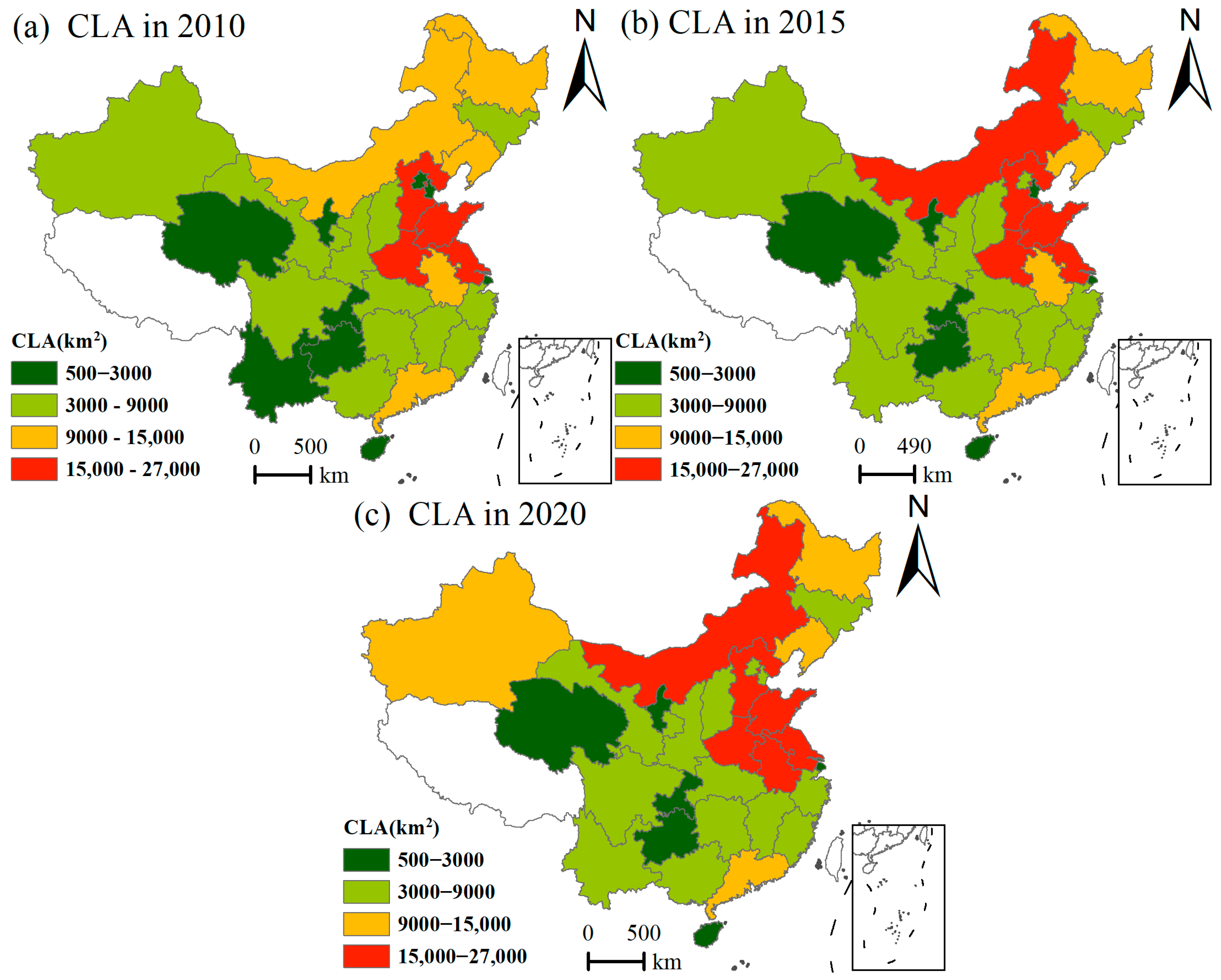
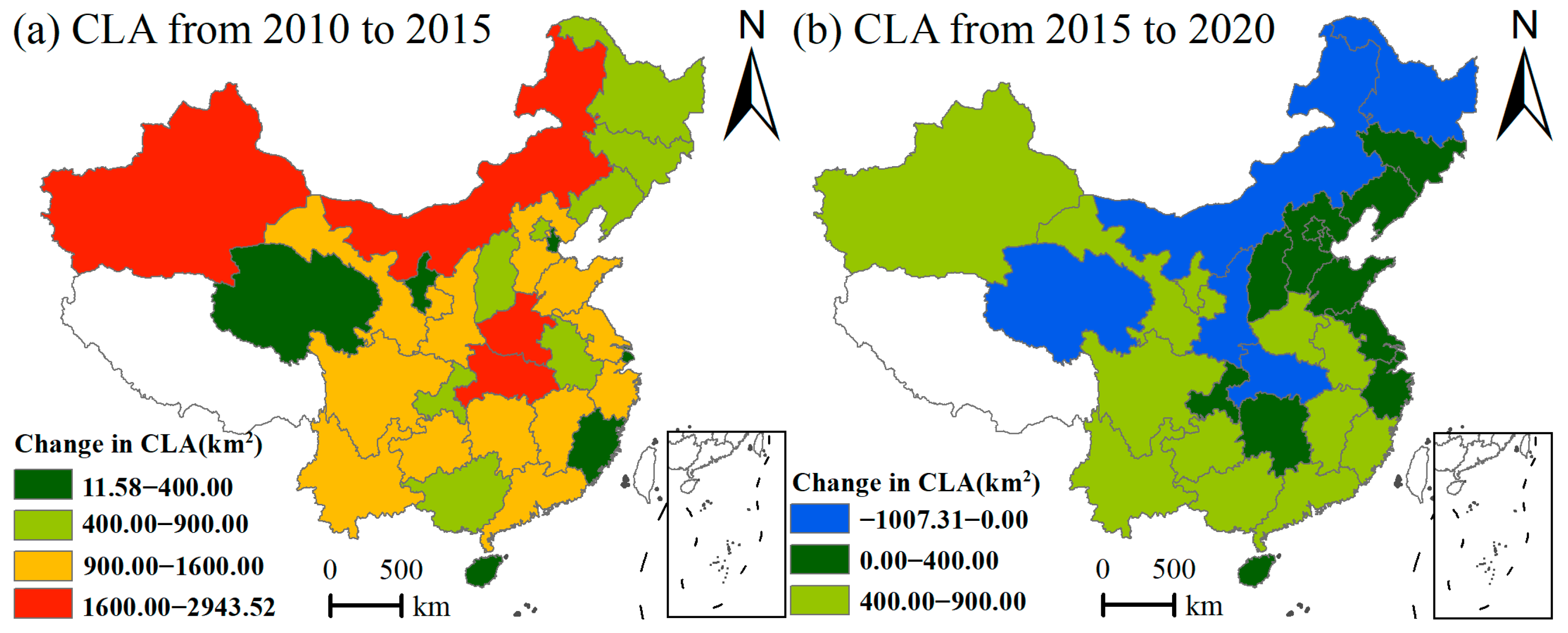

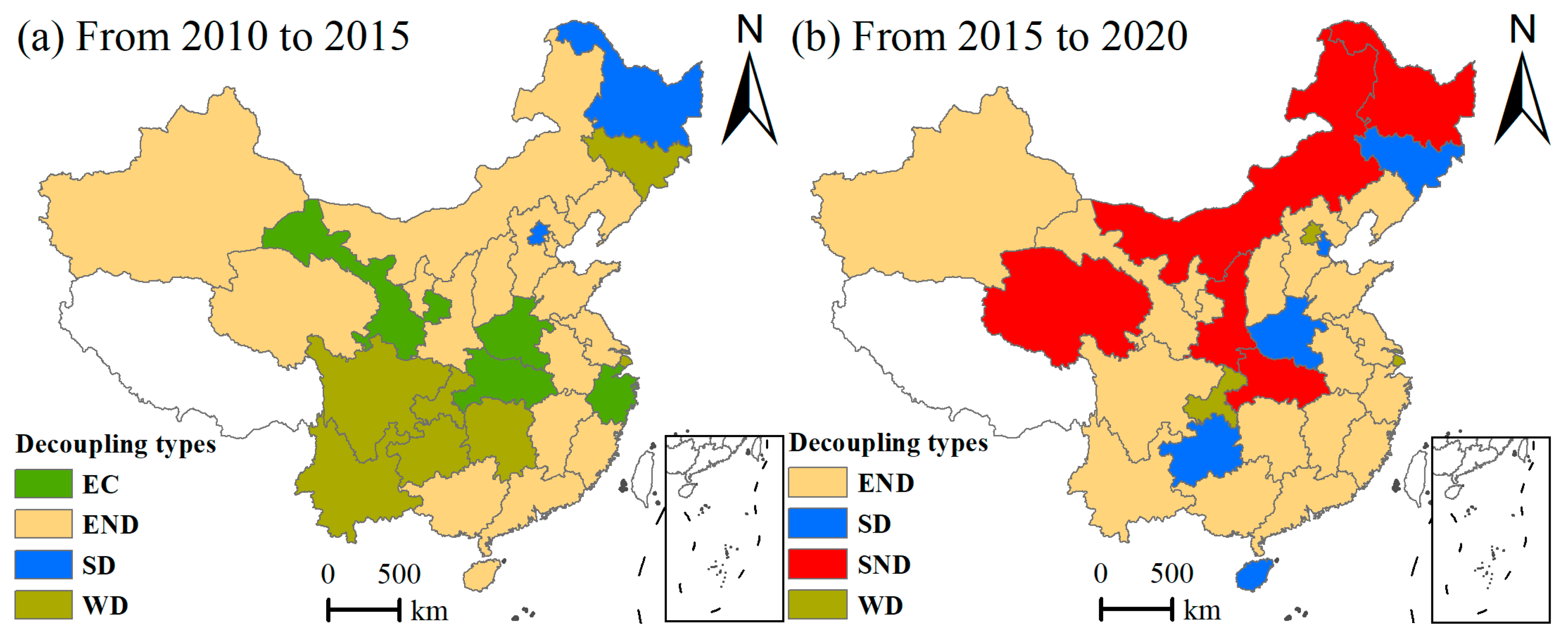
| Fossil Fuels | CP (tCO2/TJ) | OR (%) | HV (kj/(kg or m3)) | α (kgCO2/unit) |
|---|---|---|---|---|
| Raw coal | 26.37 | 93% | 20,908 | 1.8801 |
| Cleaned coal | 25.41 | 93% | 26,344 | 2.2827 |
| Other washed coal | 25.80 | 96% | 8363 | 0.7595 |
| Briquettes | 26.60 | 93% | 20,908 | 1.8965 |
| Gangue | 25.80 | 93% | 8363 | 0.7358 |
| Coke | 29.50 | 93% | 28,435 | 2.8604 |
| Coke oven gas | 12.10 | 100% | 16,726 | 0.7421 |
| Blast furnace gas | 70.80 | 100% | 3763 | 0.9769 |
| Converter gas | 49.60 | 100% | 7945 | 1.4449 |
| Other gas | 12.10 | 100% | 5227 | 0.2319 |
| Other coking products | 29.50 | 93% | 28,435 | 2.8604 |
| Crude oil | 20.10 | 98% | 41,868 | 3.0240 |
| Gasoline | 18.90 | 98% | 43,070 | 2.9251 |
| Kerosene | 19.60 | 98% | 43,070 | 3.0334 |
| Diesel oil | 20.20 | 98% | 42,652 | 3.0959 |
| Fuel oil | 21.10 | 98% | 41,816 | 3.1705 |
| Naphtha | 20.00 | 98% | 43,906 | 3.1554 |
| Lubricating oil | 20.00 | 98% | 40,200 | 2.8890 |
| White spirit | 20.00 | 100% | 42,945 | 3.1493 |
| Bitumen asphalt | 22.00 | 98% | 40,200 | 3.1779 |
| Petroleum coke | 27.50 | 98% | 32,500 | 3.2115 |
| Liquefied petroleum gas | 17.20 | 98% | 50,179 | 3.1013 |
| Refinery gas | 18.20 | 98% | 45,998 | 3.0082 |
| Other petroleum products | 20.00 | 98% | 41,816 | 3.0052 |
| Natural gas | 15.30 | 99% | 35,584.5 | 1.9763 |
| Liquefied natural gas | 17.20 | 98% | 50,179 | 3.1013 |
Disclaimer/Publisher’s Note: The statements, opinions and data contained in all publications are solely those of the individual author(s) and contributor(s) and not of MDPI and/or the editor(s). MDPI and/or the editor(s) disclaim responsibility for any injury to people or property resulting from any ideas, methods, instructions or products referred to in the content. |
© 2025 by the authors. Licensee MDPI, Basel, Switzerland. This article is an open access article distributed under the terms and conditions of the Creative Commons Attribution (CC BY) license (https://creativecommons.org/licenses/by/4.0/).
Share and Cite
Xie, F.; Cheng, J.; Yang, J.; Yu, L.; Chai, J.; Xu, D. Measurement of Building Carbon Emissions and Its Decoupling Relationship with the Construction Land Area in China from 2010 to 2020. Land 2025, 14, 1106. https://doi.org/10.3390/land14051106
Xie F, Cheng J, Yang J, Yu L, Chai J, Xu D. Measurement of Building Carbon Emissions and Its Decoupling Relationship with the Construction Land Area in China from 2010 to 2020. Land. 2025; 14(5):1106. https://doi.org/10.3390/land14051106
Chicago/Turabian StyleXie, Fangjun, Jinhua Cheng, Jianxin Yang, Li Yu, Ji Chai, and Deyi Xu. 2025. "Measurement of Building Carbon Emissions and Its Decoupling Relationship with the Construction Land Area in China from 2010 to 2020" Land 14, no. 5: 1106. https://doi.org/10.3390/land14051106
APA StyleXie, F., Cheng, J., Yang, J., Yu, L., Chai, J., & Xu, D. (2025). Measurement of Building Carbon Emissions and Its Decoupling Relationship with the Construction Land Area in China from 2010 to 2020. Land, 14(5), 1106. https://doi.org/10.3390/land14051106







